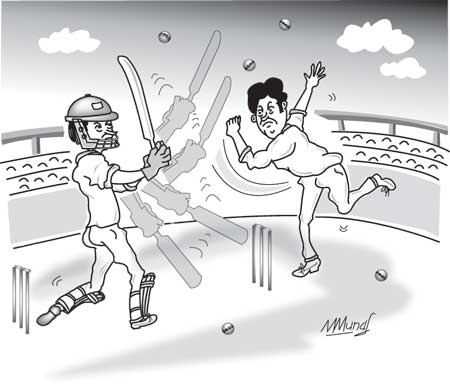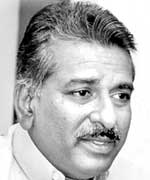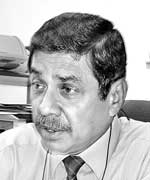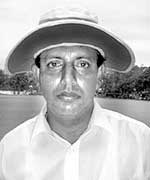
Tomorrow’s castlesTwenty-20 myth or for real?
In spite of living on the periphery of meaningful cricket for more than three decades, I am yet to come to terms with this aspect of the game. At the same time this being a World Cup Cricket Tournament of unknown quality or quantity staged by the high priests of the International Cricket Council, the news emanating from related forums has been contradictory, disturbing and intriguing. For instance Australia’s explosive all-rounder Andrew Symonds feels it would be better if the Twenty-20 World Cup stays in the carnival format while the Australian cricketing machine is very serious about adding that extra cup to their bulging trophy rack from the inaugural year itself. In the same breadth England selectors took a bold step in naming several twenty-20 specialists into their squad while India’s time tested batting trio Sachin Tendulkar, Rahul Dravid and Sourav Ganguly were granted leave of absence by their authorities. In India’s neighbouring country Pakistan, their selectors deemed it right to push ahead for the twenty-20 without the services of two of their best players in Mohammed Yousuf and Abdul Razzak, which in return enticed them to lean towards the ICL band wagon along with their former skipper Inzamam-ul-Haq while hosts South Africa dumped evergreen Jacques Kallis from their twenty-20 squad. However the Lankan selectors stuck to their conventional habits and not wishing to rock the boat named the same players in general use besides Hasantha Fernando and Gayan Wijekone.
Bewildered by the status-quo, The Sunday Musings sought the assistance of several former cricketing stalwarts. The first stop was with none other than Sri Lanka’s first Test captain Bandula Warnapura. Warnapura said , “Initially, the limited overs cricket was born by accident. A three-day game between two counties in England was washed off and on the final day when it cleared off they played a one-day game and they liked the feel of it. But the twenty-20 has come at a time when the game was well established and looking to enter every nook and cranny of spectator enjoyment, as the established game seems to be losing its gloss spectator wise.” “In the West in summer, the days are long and a game of this nature in a carnival sort of atmosphere is well accepted by the general public. With the acceptance of the quick-short version of the game the authorities learned this was a sellable product and it is also very attractive to Television Companies. This is another wing of the game that has derived through money which once again could be used for the game itself”. When asked whether derivation of this aspect of the game would impede the technicalities that are very important to the game, Warnapura said: “I think basics of cricket especially at the school level should be devoid of cricket of this nature and it should only concentrate in building well equipped technically correct cricketers. However once they reach the senior levels, the cricketers can branch into the two streams where they will become either pure entertainers or players engaged in the accepted and established form of the game”.
For another point of view we cornered Sri Lanka’s most experienced “man-in-white-coat” Asoka de Silva. His observations were -- “The International Cricket Council is harnessing the Twenty-20 version of cricket mainly to take the game into the unfamiliar terrains in the likes of China, Japan and the United States where people are not used to long-duration games like cricket and will not be able to focus their concentration for entertainment of this nature. In this manner they could induce people in those countries to take up to cricket and once they are in the game it could gradually be built-up. Ironically now what has happened is that they have also ventured inwards and introduced this tournament among the conventional cricket playing nations”. Continuing his views on the matter the ICC umpiring panel member Asoka de Silva said “There is no doubt that indulging in this aspect of the game affects the basic technicalities of a conventional cricketer. So, if they need to develop this aspect of the game they must segregate the two different types of players as much as possible. For instance, while standing at local matches I have seen players of the calibre of Kaushalya Weeraratne who has the ideal temperament for this type of cricket. I feel that selectors must identify players who have the knack to progress in this aspect of the game and with a separate squad training and developing exclusively to indulge in the twenty-20 version of cricket. This will be a progressive step in this direction”.
Musings also sought the views of Jayantha Seneviratne who has decades of experience in junior cricket and knows ways and means of developing it. Seneviratne is not a man who is willing to associate junior cricket with the Twenty-20 version. He said “junior cricket is the feeder point to the national grid and it is very important that we stick to the proper basics and teach the children to play the correct version of it,” and added “even now there are persons involved with junior cricket who feel that school cricket should be played in a limited overs basis like 75 overs a side even in a two-day inter-school match. I feel that this is detrimental and brings in a negative approach to the whole exercise.” Seneviratne continued, “when we played cricket matches they started at 12 noon on the first day and went on with a ten minute milk interval at two ‘O clock, but at that time we had more results in cricket as a consequence of our approach to the game. For instance you just see with the development of the limited overs cricket in the world arena batsmen have got used to playing a lot of unorthodox strokes while batting and as a result just see how many Test matches end in three to four days. Then just imagine once twenty-20 cricket becomes a general feature in cricket what impact it will have in the conventional version of the game because this version of the game affects not only the batsmen, but the bowlers too.” Now you can decide on how we should go about building our tomorrow’s castle. |
|| Front
Page | News | Editorial | Columns | Sports | Plus | Financial
Times | International | Mirror | TV
Times | Funday
Times || |
| |
Copyright
2007 Wijeya
Newspapers Ltd.Colombo. Sri Lanka. |

 You learn from yesterday and build your castles today to reign over the world tomorrow. In another three days hence the Sri Lankan team will be flying off to South Africa to be one of the main contenders at the inaugural Twenty-20 World Cup tournament which will be held there.
You learn from yesterday and build your castles today to reign over the world tomorrow. In another three days hence the Sri Lankan team will be flying off to South Africa to be one of the main contenders at the inaugural Twenty-20 World Cup tournament which will be held there.

